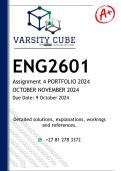Lecture notes
Lecture notes Microeconomics (EC1008) Economics taugh in all English universities
Lecture notes, practice questions, solutions, past exam papers with solutions and all other course material essential to secure a first class is available in this pdf file.
[Show more]













